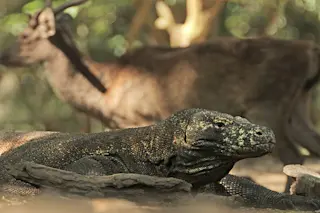(Inside Science) — Extinction wiped out their closest family members as well as most of the ancient reptiles of comparable size. But the largest lizards still on the planet, the Komodo dragon, survived due to a lucky combination of mediocre habitat on their home islands and unintended human interventions.
“You would have thought the Komodo would have been wiped out, and yet it survived,” said Rick Shine, a biologist at Macquarie University in Sydney and one of the authors of a new report on the reptiles published in the journal Global Ecology and Conservation.
Komodo dragons are both the heaviest and largest lizards on Earth. The carnivorous reptiles can weigh more than 220 pounds and reach nearly 10 feet from head to tail. They dominate the food chain on the small island of Komodo and a few neighboring islands. Their venomous bite can weaken and kill large prey like buffalo.
...















